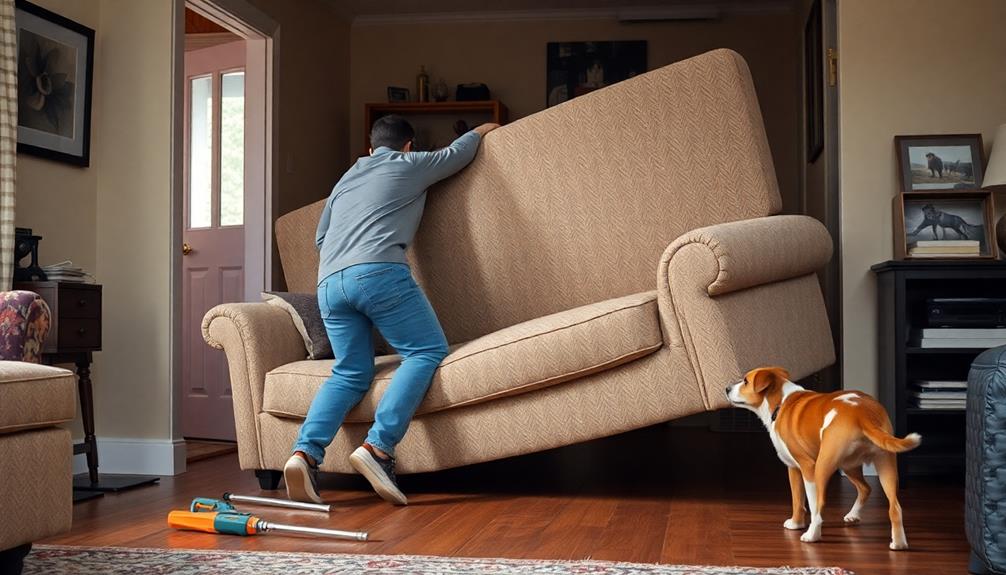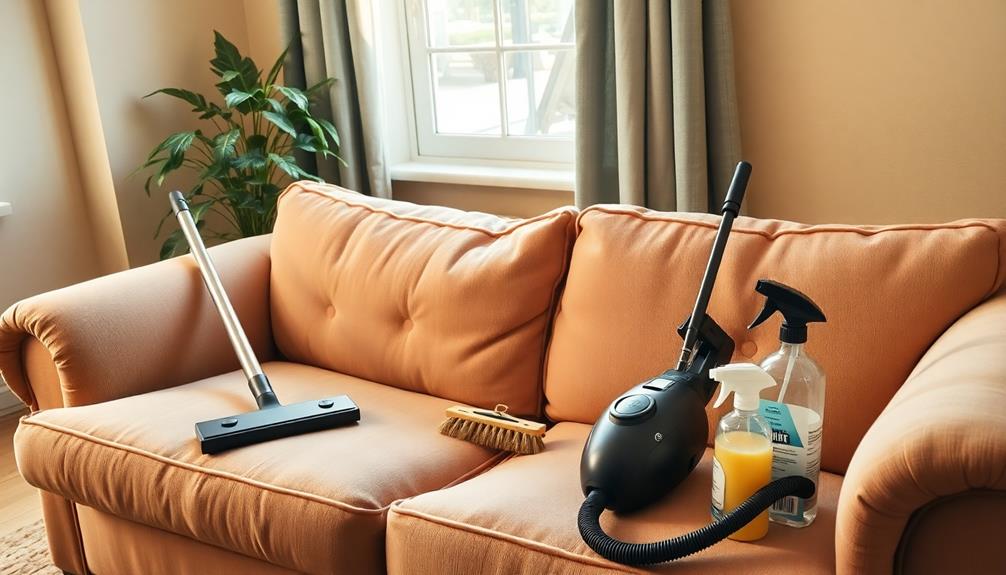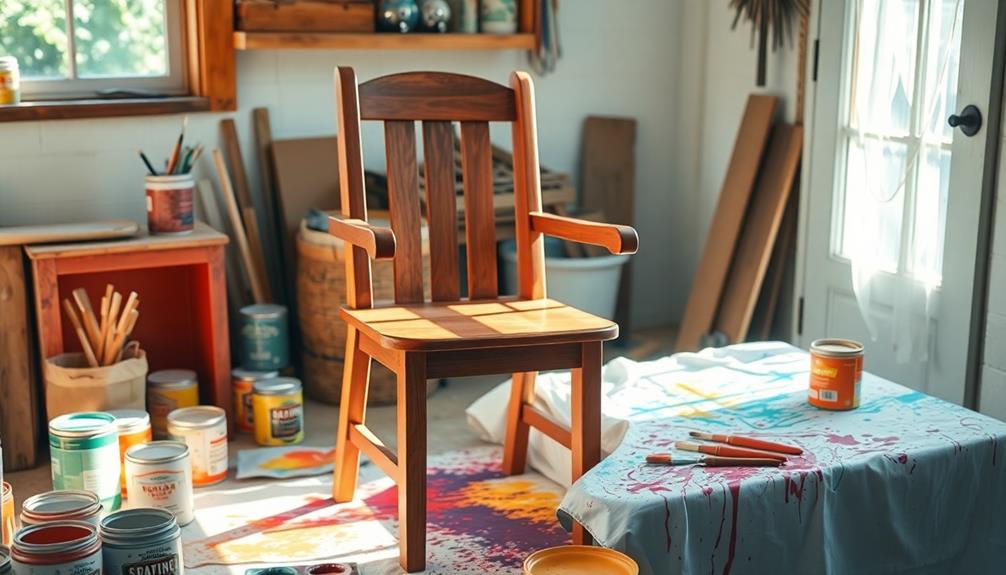Getting a sofa through a door can be challenging, but it is possible with the right approach. To begin, remove any cushions and check for detachable legs to make the sofa easier to maneuver. Measure the dimensions of the sofa against the doorway to ensure a proper fit. When you are ready, carefully angle the couch by lowering one end while turning it towards the door. If it becomes stuck, remain calm and lift the side closest to the door frame to create additional space. It may also be helpful to disassemble the couch if needed for tighter spots. There are various tips and tricks available to help you successfully navigate this task, so continue reading for more valuable insights.
Key Takeaways
- Remove cushions and detachable legs to reduce bulk and weight for easier maneuvering.
- Measure the sofa and doorway dimensions to ensure a proper fit before attempting to move.
- Use proper lifting techniques, bending your knees and keeping your back straight to avoid injury.
- Angle the sofa by creating a pivot and adjusting as needed to navigate through narrow doorways.
- If stuck, reassess and adjust the sofa's position, or consider disassembling components for easier access.
Preparation for Moving a Sofa

Preparing to move a sofa is essential for a smooth process. Start by removing any unattached items like cushions and throw pillows to reduce bulk and weight. This makes handling the couch easier. Additionally, it's wise to take into account your financial health when planning a move, as unexpected expenses can arise.
Next, check for detachable legs; taking those off can greatly help when maneuvering through narrow doorways. You should measure the sofa's dimensions—height, width, and depth—and compare them with the dimensions of the doorways and passageways. This guarantees you've got a proper fit before you attempt to move your couch. If the sofa is too large, think about disassembling it to make the task more manageable.
When you're ready to lift, use proper lifting techniques. Bend your knees and keep your back straight for balance. Tilt the couch at a 45-degree angle to maneuver through tight spaces effectively.
Don't forget to secure the sofa during transport with a strap or rope, preventing any damage or creases to the material. By following these steps, you'll minimize the risks associated with heavy lifting and set yourself up to move your couch into the proper place without a hitch.
Navigating Through the Doorway
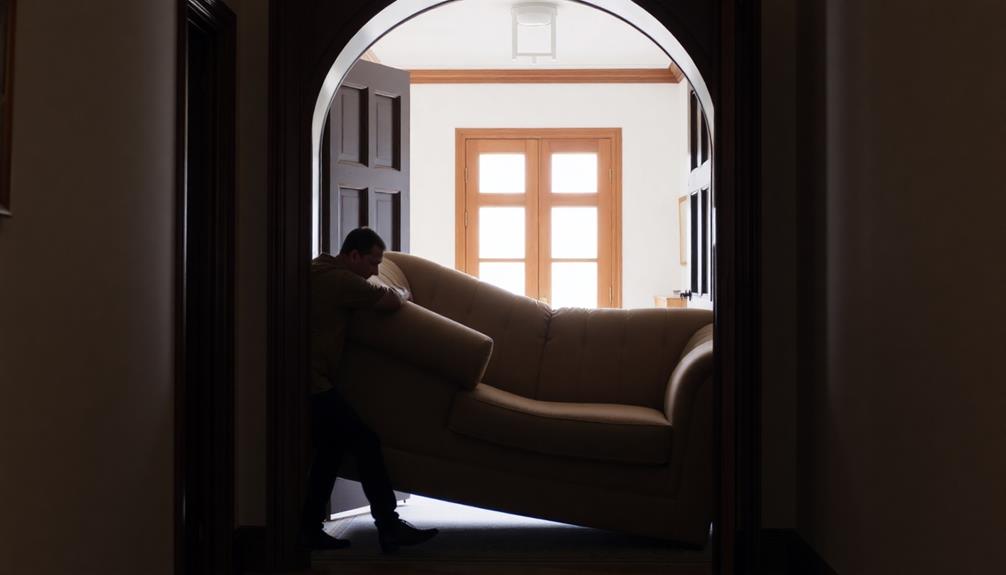
As you approach the doorway, start by guiding one side of the couch through while keeping a firm grip to maintain control and balance. Remember, moving a sofa through a narrow doorway requires finesse and patience.
Additionally, consider how the shape of the sofa might affect your approach; for instance, a boxy design may need a different strategy than a more streamlined one. Understanding the mechanics of furniture movement can make this task less intimidating, much like learning different brewing methods for coffee.
To effectively maneuver, consider these tips:
- Assess the doorway's height and width: Make sure your couch can fit without forcing it through.
- Create a pivot: Dip the opposite end of the couch while angling the arms towards the door jamb, forming a hook shape.
- Adjust as needed: If the arms don't easily pass through, tilt and adjust the angle of the couch for a better fit.
Once one arm is through, maintain a horizontal position to prevent the couch from getting stuck.
Keep in mind that small spaces can limit your movement, so you might need to be creative in your approach. By carefully adjusting the angle and making small pivots, you can successfully move the sofa without damaging either the couch or the doorway.
With practice, you'll master maneuvering through tight spaces like a pro!
Handling Obstacles
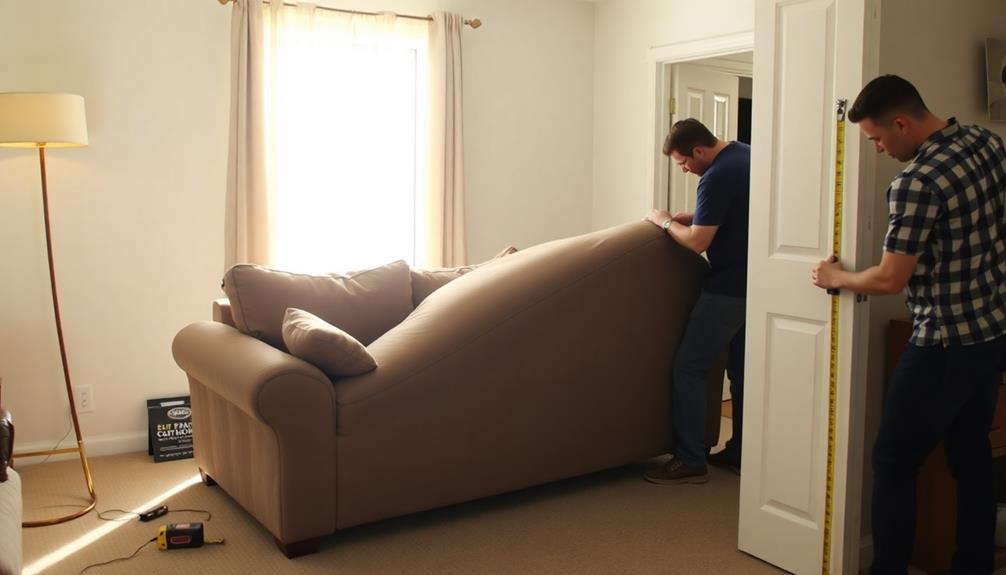
Maneuvering obstacles while moving a sofa can be challenging, but with the right techniques, you can make it easier. When you encounter a wall obstructing your pivot, lift the side of the couch closest to the door jamb. This creates more space for maneuvering. Always angle the couch appropriately to avoid hitting the top of the door jamb, ensuring it remains clear of any obstructions.
If you're dealing with a larger sofa, like a three-seater, consider disassembling components or using a semi-circle action to navigate through narrow spaces. Be prepared for adjustments based on the size and robustness of the couch arms—larger sofas may require different techniques.
If the couch gets stuck, stay calm and assess the situation. You might need to tilt or reposition the couch for better clearance.
Here's a quick reference table for handling obstacles:
| Technique | Description |
|---|---|
| Angle the Couch | Adjust the angle to avoid door jambs |
| Lift for Clearance | Raise the side near the door for better maneuvering |
| Disassemble Components | Remove parts for tight fits |
With these strategies, you can successfully carry the couch through any doorway.
Common Challenges

Moving a sofa through a doorway often presents several common challenges that can make the process frustrating. Limited doorway height can restrict tall sofas, so measuring both the couch and doorway dimensions is essential before attempting to move.
Maneuvering narrow doorways complicates things further, often requiring careful angling and pivoting techniques to guide the couch through the door openings. Additionally, considering how to master a bug out bag can help prepare you for any unexpected moving situations where you may need essential tools at hand.
Here are some common challenges you might face:
- Heavy Weight: Couches can weigh up to 350 lbs, necessitating proper lifting techniques to avoid injury while maneuvering.
- Wall Proximity: Walls adjacent to the doorway can hinder your pivoting actions, forcing you to remove the door or other obstructions to create more space.
- Stuck Couches: If your couch gets stuck, alternative strategies like disassembly or using a hoisting method may be required for a stress-free move.
Professional vs. DIY Moving

When it comes to transporting a sofa through a doorway, the choice between hiring professionals or tackling the task yourself can greatly impact the outcome.
Hiring professional removalists offers you the expertise of moving experts who know advanced techniques for getting the sofa through tight spaces, minimizing the risk of scratching both your furniture and door frame. Their friendly team can handle bulky sofas, which can weigh up to 350 lbs, making the process considerably easier for you.
Additionally, just as in the legal process of divorce, where specific steps are essential for a smooth outcome, careful planning and execution are critical when moving large furniture.
On the other hand, DIY moving might seem like a lightweight and easy option, but it often leads to injuries or damage. Many people lack the proper knowledge or equipment, like furniture sliders or dollies, making this method require more effort and care.
You might even find yourself disassembling the sofa or removing the door for better access.
If you decide to hire professionals, make sure to research and ask important questions about their methods. This guarantees you choose the right service tailored to your specific needs, resulting in a smoother moving experience.
Ultimately, the choice between professional help and DIY will depend on your comfort level and the complexity of getting the sofa through the door.
Frequently Asked Questions
What if My Sofa Doesn't Fit Through the Door?
If your sofa doesn’t fit, start by measuring it and the doorway. Remove cushions or legs, angle it, or even take off the door. If all else fails, disassemble the sofa or hire professionals. Measuring a sofa and the doorway is crucial to avoiding the frustration of trying to fit a piece of furniture through a space that is too small. It’s important to take accurate measurements and consider the dimensions of both the widest part of the sofa and the narrowest part of the doorway. In some cases, it may be necessary to take apart the sofa and reassemble it after moving it through the doorway.
How Do You Get a Couch That Is Too Big Through a Door?
You'd think a couch would fit right in, but sometimes it doesn't. Measure dimensions, remove parts, angle it just right, or even tip it. If that fails, consider disassembling or calling in the pros.
How to Dismantle a Sofa to Fit Through a Door?
To dismantle a sofa, start by removing loose cushions. Next, check for detachable parts like legs. Carefully use a screwdriver to disassemble components, and keep screws organized for easier reassembly later. Measure dimensions for fitting.
How to Figure Out if a Couch Will Fit Through a Doorway?
Imagine fitting a puzzle piece into its spot. You'll measure your couch and doorway, checking for any obstacles. Compare dimensions, and remember: tilting can be your best friend when maneuvering tight spaces!
Conclusion
So, when it comes to getting that sofa through the door, remember it's all about strategy and a sprinkle of creativity. With the right preparation and a bit of finesse, you can turn what feels like a Herculean task into a graceful waltz. Whether you tackle it solo or call in the pros, let your determination shine. After all, every couch deserves its perfect spot in your home, just like every star deserves its place in the night sky.
